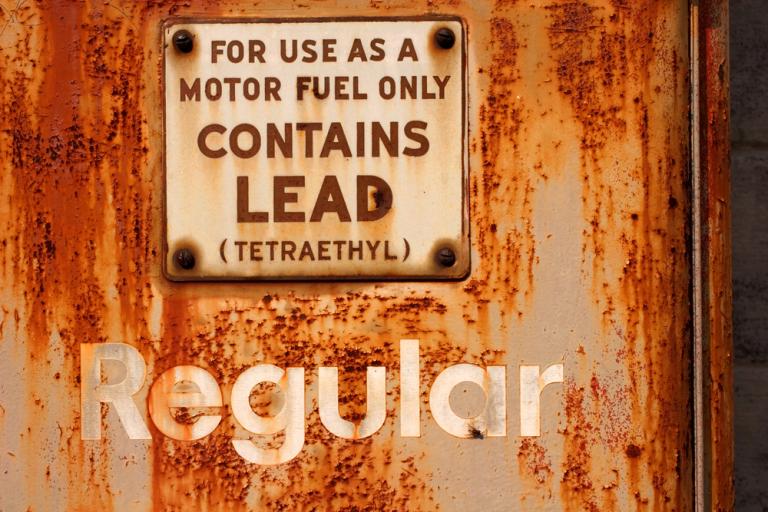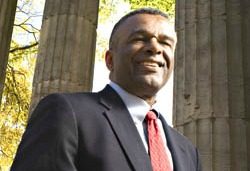
Ron Sims.
Shortly after being nominated to one of the top posts in the U.S. Department of Housing and Urban Development (HUD) in 2009, Ron Sims declared, “President Obama has … challenged his Cabinet to prepare for the age of global warming. Success can only come if we transform our major metropolitan areas.”
Ah, those were the days! The following year, the Tea Party would sweep into the House of Representatives. In 2011, Sims, who held a major elected role in the Seattle metro area before his stint in D.C., would retire to Washington state, missing his family and frustrated with the slow pace of change in the nation’s capital.
Today, roughly two years after his return to the West Coast, Sims says he sees progress. Before he went to HUD, as the county executive of King County, Wash., he led the effort to prepare the region for the unavoidable impacts of global warming and worked to weave public health concerns into planning decisions. “We realized that we could predict life outcomes of children, health outcomes of adults, by the zip code they live in,” he says. “If you have a park a quarter mile from your home, your children are not going to be obese. If it’s a half mile away, you begin to see the early signs. But if a park is a mile or more away from a residence, obesity will be a problem. How a neighborhood is designed determines health outcomes.”
As deputy secretary of HUD, responsible for the agency’s day-to-day operations, he worked to bring this awareness to decisions at the federal level, arguing for housing, transportation, and environmental policies that emphasized dense, walk- and bike-friendly development rather than car-centric sprawl. And while these efforts hit roadblock after roadblock, Sims says there has been a shift in thinking in Washington, D.C. That, combined with economic and environmental realities, he says, is reshaping American cities.
Here, Sims talks about his work in Washington, D.C., how the bill is coming due for suburban sprawl, and why he believes we may see riots in inner cities.
Q. How much progress has President Obama been able to make on urban policy issues, given the roadblocks put up by Republicans in Congress?
A. There’s a lot of silo breaking. For example, the collaboration between the EPA, the U.S. Department of Transportation, and the U.S. Department of Housing and Urban Development. Republicans in the House have attempted to put barriers to that, but you know, the fact is, the staff still meet, so there’s a culture created among how you look at urban areas.
Q. Why is this kind of collaboration so important?
A. If you look at default rates [on home loans], the biggest cause for a default in the United States was transportation costs. It often amounted to 42 percent of [the household’s] income. It was higher than the mortgage cost, which was 34 percent of income. And then you add energy cost, which varied often between 25 to 28 percent. So all you had to do was have one person [in the household] go half time [from a full-time job], and it was over.
We’ve got to look at communities and look at, how do we have people working more closely to their homes, and how do you put shopping and other things closer to people’s homes? Because people were driving distances for soccer games, distances to shop, distances to work, and you’re basically burning up a lot of money.
Now there’s another factor. From a public health aspect, we can tell you that if you’re in a car with a one-hour commute — one hour in, one hour out — we can tell you what your heart-attack risk is, based upon your race. And it’s really high no matter what race you are, right? Cause it’s not healthy. There’s an absolutely predictable health consequence.
Q. One of the main ways the federal government can affect these types of transportation and health costs is through transportation policy — but Republicans seem bent on keeping the focus on highways rather than improving mass transit or walking and biking infrastructure.
A. HUD and EPA, working with USDOT and the departments of Agriculture and Interior, worked in a collaborative process on the transportation bill. A lot of that got taken out [of the bill in Congress]. But you can’t build a modern transportation infrastructure using an old model. It just doesn’t work. You simply are not gonna build any more highways in major metropolitan areas because they become cost-prohibitive. You can’t tear out hospitals and schools and neighborhoods in order to expand a freeway.
The reliance on the gas tax is also part of the discussions. I have a hybrid, right? It gets 42.8 miles to the gallon. So I get to use roads much more cheaply than my son, who’s in a Highlander that gets 28 miles per gallon. My next cars, though, will either be electric or even more fuel-efficient, as will his. So that gas tax dives. The only solution is going to be a toll or another mechanism. [Transportation Secretary] Ray LaHood talked about actual miles driven — requiring locators on cars and seeing what roads I’m on and what time of day, and have that as a [basis of] payment.
Q. So you and I look at that and we see a system that will attach the true costs to driving and sprawl. But there are some who see tolls and per-mile fees as part of the “war on the suburbs.”
A. Well it’s not a war on suburbs. You know, here’s what happens. We had dense cities, and people said, “I want a better quality of life so I’m moving to the suburbs.” But every time we move away, growth never pays for itself. When you look at the infrastructure — whether it’s for water or for roads, electricity, police, fire — all that stuff costs money. So it is subsidized by areas that already have their infrastructure put in place. And that’s how most suburbs grew. Suburbs had free lunches. And what’s happened now is, the true bill for that is now arriving.
So you look at a place like Washington, D.C., where people tended to move farther and farther and farther away. You take a look at those highways, and go wow, when the true bill comes, this is gonna be an ouch. So people will begin to move into the city, because at least they’ll be home at a reasonable time. Their jobs will be nearby. And people will begin to say, “My life is better. I’m not on the highway.”
Q. We’ve seen some of this — people moving into downtown areas — but many American cities are in rough shape. You’ve even mentioned the possibility of riots.
A. Oh, I think they’re gonna happen. It’s unavoidable.
Q. What do you see out there that makes you think riots are inevitable?
A. We have the largest group of people who are chronically unemployed for a longer period of time than we’ve ever had in our history. Unemployment hit communities of color the second year of President [George W.] Bush’s administration. And we have never in this country faced the issues. You can only hang so long — “What are you doin’ today, man?” “Just hangin’.”
These riots will occur not because of something the president’s gonna do in terms of direct policy. It’s gonna be something that all of a sudden fires up people in a big, big way. It’s gonna be a law-enforcement issue, probably, and then, boom, it’ll be the match on the flammable substances.
Q. Riots in 1968 were the beginning of the end for cities like Baltimore. Anyone who could get out of the city did. If we do see riots again, what happens then?
A. You want to avoid those, because there’s no good side to them. You can’t have cities that look uninhabitable, undesirable — you just can’t.
Q. If you could push one policy initiative in the next two to four years to make a difference for America’s cities, what would it be?
A. Chronic unemployment — that’s gonna be really important. Dealing with climate change and adaptation from an urban level is gonna be critically important. I’d probably choose those two first. There’s ways to implement both: If a city’s going to adapt, it’s gonna rebuild itself or redesign itself.
These look like challenges that are overwhelming. They’re not. They’re opportunities — opportunities to be smarter than ever. And urban mayors, urban electeds, people living in urban areas, and the business community in those urban areas are gonna have to be out of their silos, talking about common visions and purposes, and driving the change. I think we can do that.



